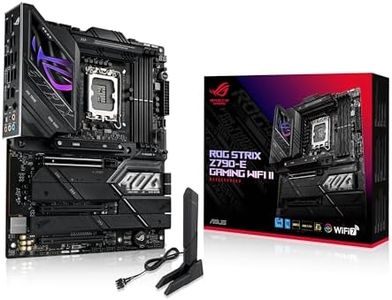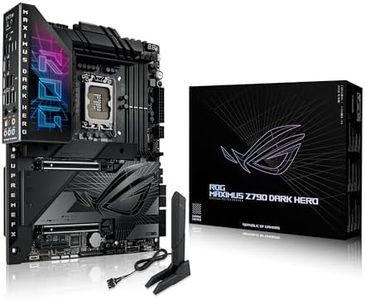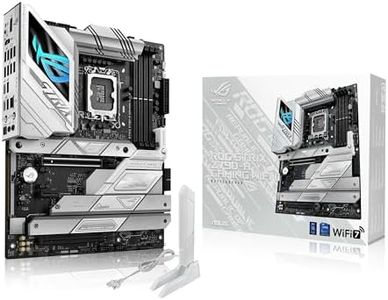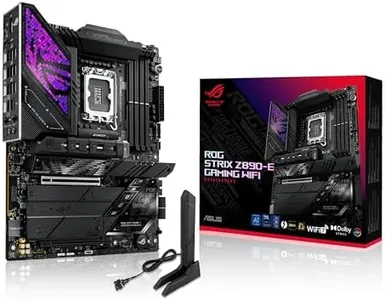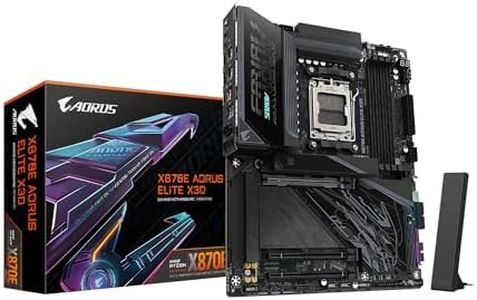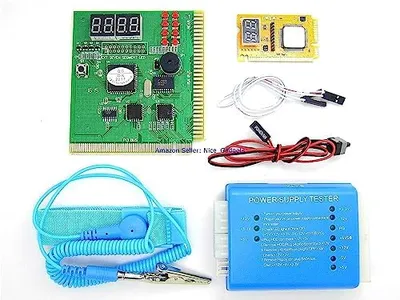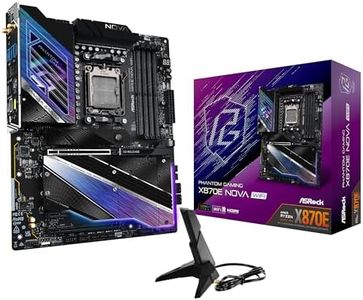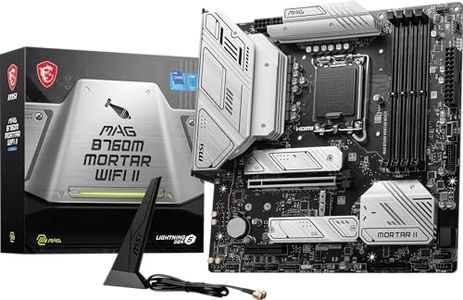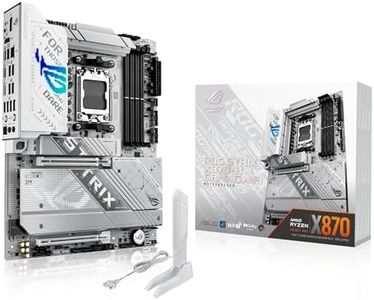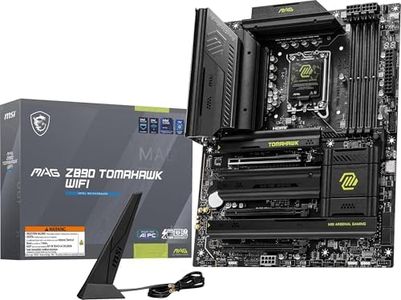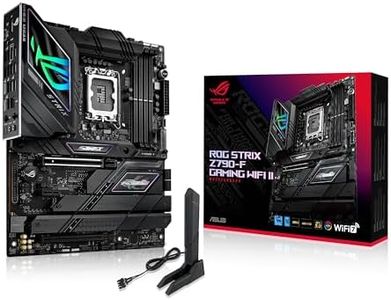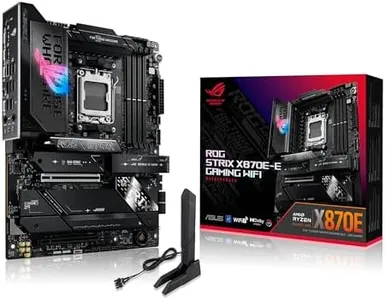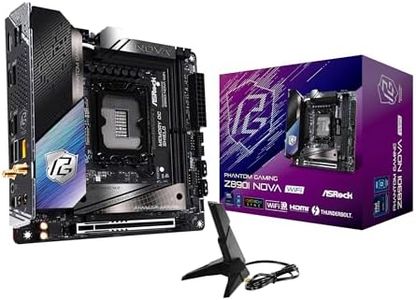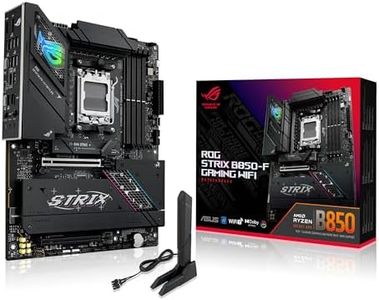10 Best Gaming Motherboard 2025 in the United States
Our technology thoroughly searches through the online shopping world, reviewing hundreds of sites. We then process and analyze this information, updating in real-time to bring you the latest top-rated products. This way, you always get the best and most current options available.

Our Top Picks
Winner
ASUS ROG Strix Z790-E Gaming WiFi II LGA 1700(Intel 14th & 13th & 12th Gen)ATX gaming motherboard(DDR5,PCIe 5.0,2.5 Gb LAN,5XM.2 slots,PCIe 5.0 x16,WiFi 7 front-panel connector with PD 3.0 up to 30W.
Most important from
170 reviews
The ASUS ROG Strix Z790-E Gaming WiFi II is a powerful motherboard designed specifically for gamers and PC builders looking for high performance. With support for Intel’s 12th, 13th, and 14th Gen processors using the LGA 1700 socket, this motherboard is versatile and future-proof for upcoming CPUs. Its robust power solution, featuring 18+1+2 power phases, ensures stability even when running demanding applications or overclocking, which is a significant advantage for gamers pushing their systems to the limit.
One of the standout features is the next-gen M.2 support, accommodating fast PCIe 5.0 M.2 slots and providing ample storage options with five M.2 slots in total, ensuring you can utilize high-speed SSDs for quicker load times. Coupled with excellent connectivity options, including a USB 20Gbps port and multiple USB 10Gbps ports, it offers plenty of expansion possibilities. The integrated WiFi 7 and 2.5 Gb LAN ensure that you have fast and reliable internet connections, which is crucial for online gaming.
There are considerations to keep in mind. The price point may be on the higher side, making it less accessible for budget gamers. Additionally, while the motherboard supports up to 192 GB of RAM, not all users may need that much, leading to potential over-specification for casual gamers. The physical size of the motherboard (ATX form factor) may also pose compatibility issues for smaller cases. This motherboard excels in providing high-end features suitable for serious gamers and performance enthusiasts, while casual users might find it more than what they need.
Most important from
170 reviews
ASUS ROG Maximus Z790 Dark Hero (WiFi 7) LGA 1700(Intel 14th &13th&12th Gen) ATX Gaming Motherboard(PCIe 5.0x16, 5xM.2 Slots,DDR5,2X Thunderbolt 4 Ports, USB Type-C Front-Panel)
Most important from
879 reviews
The ASUS ROG Maximus Z790 Dark Hero is a powerful motherboard designed for gamers looking for high-performance capabilities. With its LGA 1700 socket, it supports Intel's latest 12th, 13th, and 14th Gen processors, ensuring you can take advantage of the latest advancements in CPU technology. The motherboard supports up to 192GB of DDR5 RAM, which is great for multitasking and running memory-intensive applications or games smoothly. The robust power solution, featuring 20+1+2 power stages, guarantees stability even during heavy loads, making it suitable for overclocking enthusiasts.
Another significant strength is its cooling design. The motherboard comes with large heatsinks and an innovative thermal solution that helps keep temperatures down, which is essential during intense gaming sessions. The inclusion of PCIe 5.0 M.2 slots means you can enjoy faster storage options, enhancing load times and system responsiveness.
Connectivity is another highlight with dual Thunderbolt 4 USB Type-C ports, a versatile array of USB ports, and HDMI 2.1 support for high-resolution displays. This makes it ideal for gamers who use multiple peripherals or external displays. However, this motherboard is on the pricey side, which may not appeal to budget-conscious gamers. Additionally, while it’s packed with features, some users might find it overwhelming if they are new to building PCs or gaming setups. It may also require a more powerful PSU to match its high-end capabilities, which is an added expense. Lastly, the size (ATX) means it needs a compatible case, limiting options for those working with smaller builds.
The ASUS ROG Maximus Z790 Dark Hero stands out as a top-tier choice for serious gamers focusing on performance, connectivity, and future-proofing. However, the higher price tag and complexity may not suit every user.
Most important from
879 reviews
ASUS ROG Strix Z790-A Gaming WiFi II (WiFI 7) LGA 1700(Intel 14th & 13th & 12th Gen) ATX gaming motherboard(DDR5,5X M.2 slots,PCIe 5.0 x16,front-panel USB connector with PD 3.0 up to 30W)
Most important from
1328 reviews
The ASUS ROG Strix Z790-A Gaming WiFi II motherboard is designed for high-performance gaming and supports Intel's latest 14th, 13th, and 12th Gen processors with its LGA 1700 socket. Its ATX form factor is suitable for most gaming PC builds, providing ample space for components. One of its standout features is the support for DDR5 memory, which delivers faster speeds and better performance compared to DDR4. It also offers a robust power solution with a 16+1+2 power stage design, ensuring stability and efficiency for multi-core processors.
The thermal management is well-optimized with large heatsinks and high-conductivity thermal pads, keeping the system cool during intense gaming sessions. The motherboard provides generous M.2 slots with five available, allowing for extensive storage expansion and fast data access. Connectivity is also a strong point, featuring multiple high-speed USB ports, a front-panel USB connector with fast charging capabilities, HDMI 2.1, DisplayPort 1.4, and PCIe 5.0 x16 slots for the latest graphics cards. The inclusion of WiFi 7 ensures fast and reliable wireless internet connectivity.
However, while it has many premium features, the motherboard may be overkill for casual gamers or those on a budget. Additionally, users will need to invest in compatible DDR5 RAM, which can be more expensive than DDR4. Despite these points, for serious gamers or those looking to future-proof their system, the ASUS ROG Strix Z790-A Gaming WiFi II offers excellent performance and connectivity options.
Most important from
1328 reviews
Buying Guide for the Best Gaming Motherboard
Choosing the right gaming motherboard is crucial for building a high-performance gaming PC. The motherboard is the backbone of your system, connecting all the components and allowing them to communicate with each other. When selecting a gaming motherboard, you need to consider several key specifications to ensure compatibility and performance that meets your gaming needs. Understanding these specs will help you make an informed decision and build a system that delivers the best gaming experience.FAQ
Most Popular Categories Right Now
